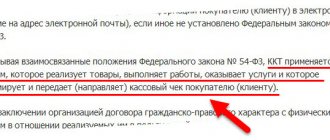The organization has the right to transfer to the counterparty a bill of exchange of a third party in payment of its debt. Such a transfer means the repayment of obligations (part of the obligations) of the organization to the counterparty.
This follows from articles 407 and 409 of the Civil Code of the Russian Federation.
Attention: settlements using bills of exchange (including third parties) increase the risk of conducting an on-site tax audit for all participants in the bill of exchange transaction (clause 12 of Appendix 2 to the order of the Federal Tax Service of Russia dated May 30, 2007 No. MM-3-06/333 ).
Accounting
Interest (discount) bill
In accounting, reflect the transfer of an interest-bearing (discount) bill of exchange from a third party to a counterparty in payment for goods (work, services) as a disposal of financial investments (clause 25 of PBU 19/02). That is, in correspondence with account 58 “Financial investments” sub-account “Debt securities” (58-2) (Instructions for the chart of accounts).
As part of other income, recognize the value of the transferred bill of exchange, which is equal to the entire amount of the debt repaid by it (clauses 7 and 10.1 of PBU 9/99). And the expenses include the cost of the bill reflected in account 58-2, and interest accrued until the bill is disposed of (clause 11 of PBU 10/99). Make the following entries:
Debit 60 (76) Credit 91-1 – a bill of exchange of a third party was transferred in payment for goods (work, services);
Debit 91-2 Credit 58-2 – the value of a third party’s bill of exchange is written off, at which it is recorded at the time of its transfer;
Debit 91-2 Credit 76 subaccount “Interest on bills received” - accrued but uncollected interest on a third party bill is written off.
This scheme of accounting entries follows from the Instructions for the chart of accounts (accounts 58, 91).
Interest-free (discount-free) bill
The transfer of an interest-free (non-discount) bill of exchange of a third party to a counterparty in payment for goods (work, services) should be reflected in the debit of account 91 “Other income and expenses” in the subaccount “Other expenses” (91-2) in correspondence with account 76. That is, the account on which the transferred security is accounted for.
Make an entry in accounting:
Debit 91-2 Credit 76 subaccount “Settlements on bills received” - reflects the transfer of a bill in payment for goods (work, services).
This follows from the Instructions for the chart of accounts (accounts 76 and 91) and paragraphs 11 and 17 of PBU 10/99.
Reflect the disposal of the bill at the value at which it was recorded on the date of transfer.
Documenting
Confirm the fact of transfer of the bill and the date of the transaction with a primary document drawn up in any form; a unified form is not provided. For example, this may be an act of acceptance and transfer of bills of exchange from third parties, containing all the required details in accordance with paragraph 2 of Article 9 of the Law of December 6, 2011 No. 402-FZ. At the same time, it is necessary to issue an endorsement on the transfer of all rights under the bill (clause 3 of Article 143, clause 3 and subclause 2 of clause 8 of Article 146 of the Civil Code of the Russian Federation).
Situation: is the transfer of a third party’s bill of exchange to a counterparty in payment for purchased goods (works, services) for tax purposes?
Yes it is.
For tax purposes, the transfer of a bill of exchange in payment for goods (work, services) leads to two transactions:
- for the acquisition of goods (works, services);
- for the sale of securities.
This follows from the provisions of Article 128, paragraph 2 of Article 142 of the Civil Code of the Russian Federation, paragraphs 2, 3 of Article 38, paragraph 1 of Article 39 of the Tax Code of the Russian Federation and is explained by letters of the Ministry of Finance of Russia dated October 10, 2006 No. 03-11-04/2/202 , dated June 6, 2005 No. 03-04-11/126, dated November 24, 2004 No. 03-03-01-04/1/141, Ministry of Taxes of Russia dated June 15, 2004 No. 03-2-06/ 1/1372/22.
In arbitration practice there are examples of court decisions that recognize the legitimacy of such a conclusion (see, for example, the decision of the Supreme Arbitration Court of the Russian Federation dated May 18, 2007 No. 5697/07, the resolution of the FAS Volga District dated January 26, 2007 No. A57-16025/05 -33).
Advice: there are arguments that allow an organization that pays a counterparty with a third party bill of exchange not to recognize its transfer as an operation to sell a security. They are as follows.
Depending on the purpose of the transfer, the bill of exchange can be used as:
- method of drawing up a loan agreement;
- securities as a way to generate additional income;
- means of settlements with counterparties.
This follows from Article 5, paragraph 2 of Article 142, Article 815, paragraph 1 of Article 408, Article 862 of the Civil Code of the Russian Federation, the Regulations approved by the resolution of the Central Executive Committee of the USSR and the Council of People's Commissars of the USSR dated August 7, 1937 No. 104/1341, and the ruling of the Constitutional Court of the Russian Federation dated April 4, 2006 No. 98-O.
As a rule, when transferring a bill of exchange in payment for goods (work, services), the bill itself is not the object of the transaction, but a means of settlement with counterparties (a means of payment). The transfer of a bill of exchange as payment is equivalent to the transfer of funds. That is, the bill in this case is not a commodity in the sense of paragraph 3 of Article 38 and paragraph 1 of Article 39 of the Tax Code of the Russian Federation. This means that its sale does not occur when repaying the debt to the counterparty. This point of view is confirmed by arbitration practice (see, for example, the rulings of the Supreme Arbitration Court of the Russian Federation dated August 11, 2009 No. VAS-10058/09, dated February 8, 2008 No. 910/08, dated February 4, 2008 No. 403/08, dated August 29, 2007 No. 10480/07, dated April 20, 2007 No. 4773/07, resolution of the Federal Antimonopoly Service of the Moscow District dated March 11, 2009 No. KA-A40/1255-09, dated December 11, 2007 No. KA- A40/12645-07-2, West Siberian District dated May 7, 2007 No. F04-2543/2007(33746-A27-40), Volga District dated October 23, 2007 No. A57-13898/2006, Ural District dated September 24, 2008 No. Ф09-6808/08-С3, dated October 1, 2007 No. Ф09-7982/07-С3, dated February 8, 2007 No. Ф09-363/07-С3 and dated January 16, 2007 No. Ф09-11811/06-С3, Volga-Vyatka District dated June 22, 2006 No. A31-2731/2005-13).
BASIC
The transfer of a third party's bill of exchange in payment for goods (work, services) leads to the emergence of two transactions for tax purposes (for the acquisition of goods (work, services) and for the sale of a security).
Purchased goods (work, services) paid for by a third party bill of exchange must be taken into account when calculating income tax, depending on:
- on the tax accounting rules that apply to the corresponding type of expenses;
- on the method that the organization uses when calculating income tax (accrual method or cash method).
At the same time, with the cash method of calculating income tax, goods (work, services), in payment for which the organization transferred a bill of exchange to a third party, are considered paid at the time of its transfer.
This follows from articles 252, 272 and 273 of the Tax Code of the Russian Federation.
In addition, it is necessary to generate a financial result from the sale of a security (Article 280 of the Tax Code of the Russian Federation, letters of the Ministry of Finance of Russia dated March 21, 2011 No. 03-02-07/1-79, dated November 24, 2004 No. 03-03-01 -04/1/141). It is determined according to the rules of Article 280 of the Tax Code of the Russian Federation.
Transactions on the sale of securities are not subject to VAT. Therefore, the transfer of a bill of exchange in payment for goods (work, services) is also not subject to taxation. This follows from subparagraph 12 of paragraph 2 of Article 149 of the Tax Code of the Russian Federation and is confirmed by letter of the Ministry of Finance of Russia dated March 21, 2011 No. 03-02-07/1-79. For more information about this, see How to pay VAT when paying by bill of exchange.
In this case, input VAT on goods (works, services) paid by bill of exchange can be deducted in the general manner - after the goods are accepted for registration, if there is an invoice and other necessary conditions are met (clause 2 of Article 171, clause 1 of Art. 172 of the Tax Code of the Russian Federation). For more information about this, see How to pay VAT when paying by bill of exchange.
An example of reflection in accounting and taxation of transactions for the acquisition of goods paid for by a bill of exchange of a third party. The market value of this bill is not determined. The organization applies a general taxation system
On April 1, CJSC Alfa acquired a promissory note with a face value of 300,000 rubles.
On August 16, Alpha paid the supplier Torgovaya LLC for goods purchased from him worth 354,000 rubles. (including VAT – RUB 54,000) by a third party’s bill of exchange. The interest rate on the bill is 10 percent per annum.
The value of the bill on the date of its transfer was recognized by the parties as equal to the value of the goods, including VAT.
The cost of the bill in accounting and tax accounting on the date of its transfer was 300,000 rubles. The amount of interest accrued by Alfa at the time of transfer of the bill and previously taken into account for taxation is equal to 11,260 rubles. (RUB 300,000 × 10%: 365 days × 137 days).
Alpha's accounting policy for tax purposes provides for determining the settlement price for debt securities based on their nominal value and profitability conditions.
The actual price of the bill (RUB 354,000) at the time of transfer to Hermes does not deviate from the estimated price by more than 20 percent.
To account for interest accrued on a bill of exchange, the accountant opened a subaccount for account 76 “Interest on bills received.”
On August 16, the following entries were made in Alpha’s accounting records:
Debit 41 Credit 60 – 300,000 rub. (RUB 354,000 – RUB 54,000) – purchased goods are capitalized;
Debit 19 Credit 60 – 54,000 rub. – input VAT on purchased goods is taken into account;
Debit 68 subaccount “Calculations for VAT” Credit 19 – 54,000 rubles. – accepted for deduction of VAT on purchased goods;
Debit 60 Credit 91-1 – 354,000 rubles. – a third party’s bill of exchange has been transferred in payment for goods;
Debit 76 subaccount “Interest on bills received” Credit 91-1 – 1315 rubles. (RUB 300,000 × 10%: 365 days × 16 days) – interest accrued on a third party’s bill for August;
Debit 91-2 Credit 58-2 – RUB 300,000. – the value of a third party’s bill of exchange, at which it was recorded at the time of its transfer, has been written off;
Debit 91-2 Credit 76 subaccount “Interest on bills received” – 11,260 rubles. – accrued but uncollected interest on a third party’s bill of exchange for the entire period of its ownership by the organization is written off.
Alpha pays income tax monthly and uses the accrual method.
When calculating income tax for August, Alpha’s accountant included interest in the amount of 1,315 rubles in non-operating income.
The taxable profit on the transfer of a third party's bill of exchange as payment for goods was determined by the Alpha accountant as follows: RUB 354,000. – 300,000 rub. – 11,260 rub. = 42,740 rub.
The amount of debt to the supplier, in payment for which the bill of exchange was transferred (income - 354,000 rubles), the accountant reflected in the income tax return on line 011 of sheet 05.
The cost of the transferred bill of exchange (expense - 300,000 rubles) was reflected by the accountant in the income tax return on line 021 of sheet 05.
The amount of interest previously included in non-operating income (non-operating expense - 11,260 rubles) was reflected by the accountant on line 200 of Appendix No. 2 to sheet 02 of the income tax return.
Features of the transfer of bills
In order to transfer your own bill of exchange to someone, you need
- indicate in the contents of the bill of exchange the addressee - the holder of the bill (i.e. the one to whom this bill is transferred);
- In order to document the fact of transfer, a special act should be drawn up.
If a bill of exchange is transferred in the execution of any agreement, a reference to it should be given in the act (indicating the number and date of conclusion).
In addition to the information that will directly relate to the bill of exchange, the act must necessarily contain the details of both parties (information from the registration papers of the organization or the passport data of an individual) - without them, the document will not become legally significant.
It is permissible to draw up an act not only personally, but also acting through a representative. However, in this case, it is necessary that the trusted person has in his hands a notarized power of attorney, a copy of which must be attached to the act (noting its presence in the document itself).
It should be noted that in some cases, the transfer of a bill of exchange occurs in the presence of witnesses - information about them must also be included in the act, and the document itself must be endorsed by them.
simplified tax system
The transfer of a third party's bill of exchange in payment for goods (work, services) leads to the emergence of two transactions for tax purposes (for the acquisition of goods (work, services) and for the sale of a security).
If an organization pays a single tax on income, on the date of transfer of the bill of exchange to the counterparty, the tax base must be increased by the cost of goods received (work performed, services rendered) for which the organization pays with this third party bill of exchange. That is, to recognize income from the sale of the bill (clause 1 of article 346.15, clause 1 of article 249, clause 1 of article 346.17 of the Tax Code of the Russian Federation, letter of the Ministry of Finance of Russia dated October 10, 2006 No. 03-11-04/2/202 ).
Do the same when calculating the single tax on the difference between income and expenses (clause 1 of Article 346.15 of the Tax Code of the Russian Federation, letter of the Ministry of Finance of Russia dated October 10, 2006 No. 03-11-04/2/202). However, the tax base can be reduced by the amount of expenses. Reduce the income received by the cost of purchasing the bill (clause 2 of Article 280, subclause 23 of clause 1 of Article 346.16 of the Tax Code of the Russian Federation, letter of the Ministry of Finance of Russia dated January 24, 2011 No. 03-11-06/2/08).
Expenses for which the organization paid with a third party’s bill of exchange shall be considered paid on the date of its transfer. Accept them for accounting at the transaction price, but not more than the amount of the debt obligation specified in the bill. This procedure is established by subparagraph 5 of paragraph 2 of Article 346.17 of the Tax Code of the Russian Federation. At the same time, to calculate the single tax, take into account the peculiarities of accounting for certain types of expenses when simplifying. For example, expenses for the purchase of goods for which a bill of exchange was transferred can be taken into account only after sale (subclause 23, clause 1 and clause 2, article 346.16, subclause 2, clause 2, article 346.17 of the Tax Code of the Russian Federation).
Accounting for bills of exchange as securities
It can be organized by the enterprise at its own discretion, since the corresponding procedure is not legally established. However, the need to account for bills of exchange is obvious, because they can be at the enterprise for a limited period and, due to various business transactions, be disposed of.
Therefore, when a security arrives at an enterprise, it is advisable to register it in the accounting journal (book), indicating its series, number, drawer, denomination, acquisition cost, person from whom the security was received, basis for acquisition, date and reason for disposal, endorser, maturity date etc. In addition to registration, making a copy would also be a useful action.
A document recording receipt is, for example, an acceptance certificate.
UTII
The transfer of a third party's bill of exchange in payment for goods (work, services) leads to the emergence of two transactions for tax purposes (for the acquisition of goods (work, services) and for the sale of a security).
The object of UTII taxation is imputed income (clause 1 of Article 346.29 of the Tax Code of the Russian Federation). Therefore, the transaction for the acquisition of goods (work, services) will not affect the calculation of the tax base.
The operation of selling a bill of exchange does not fall under the special regime, since this type of activity is not listed in paragraph 2 of Article 346.26 of the Tax Code of the Russian Federation. Consequently, income and expenses when transferring a bill of exchange in payment for goods (work, services) should be taken into account in the tax base when calculating income tax (clause 9 of Article 274 of the Tax Code of the Russian Federation).
OSNO and UTII
The transfer of a third party's bill of exchange in payment for goods (work, services) leads to the emergence of two transactions for tax purposes (for the acquisition of goods (work, services) and for the sale of a security).
If an organization uses a general system and pays UTII, then accounting for expenses for the purchase of goods (work, services) paid for by a bill of exchange depends on which regime this operation belongs to. Goods (work, services) purchased for activities under the general taxation regime should be taken into account according to the rules in force when calculating income tax. If they were purchased for activities for which the organization pays UTII, then do not take such expenses into account when calculating the single tax. The object of UTII taxation is imputed income (clause 1 of Article 346.29 of the Tax Code of the Russian Federation).
If an organization uses goods (work, services) for both types of activities, expenses must be distributed (clause 9 of Article 274 of the Tax Code of the Russian Federation). For more details, see What taxes to pay with UTII.
Income and expenses from the sale of a third party's bill of exchange should be taken into account when calculating income tax (clause 9 of Article 274 of the Tax Code of the Russian Federation), regardless of whether the bill of exchange was transferred to pay expenses for what type of activity. The operation of selling a bill of exchange does not fall under UTII, since this type of activity is not listed in paragraph 2 of Article 346.26 of the Tax Code of the Russian Federation.
Features and pitfalls
Only if all important conditions are met can you draw up a loan agreement for individuals or legal entities using a promissory note. All stated provisions must not infringe on the rights of the parties to the contract. Otherwise, the transaction will be declared invalid. In addition, a whole list of documents is being prepared.
This type of security can be used as regular collateral. It is worth noting that the loan agreement by promissory note is not as simple as it seems at first glance. There are both pros and cons to using it.
Key points to consider before signing:
- detailed conditions;
- how it is compiled;
- list of required documents;
- return procedure;
- Advantages and disadvantages;
- basic moments;
- how relationships are regulated.










